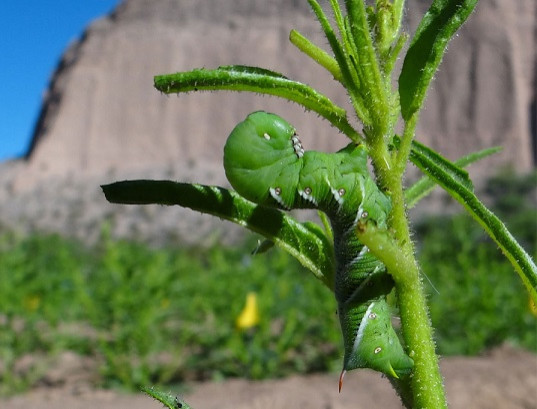Caterpillar Uses Bad Breath As Defense Mechanism: Nicotine-Laden Halitosis Scares Off Spider [VIDEOS]

The tobacco hornworm, a kind of moth larva that feeds on tobacco plants, has a special trick up its sleeve for scaring off predators: bad breath.
German scientists from the Max Planck Institute for Chemical Ecology have found that the tobacco hornworm retains some of the nicotine in the tobacco plant in its body, and “puffs” it out to warn away those that would make a meal of it. The researchers also found a genetic switch that could turn off the caterpillar’s defenses, curing its bad breath but making it much more likely to be gobbled up.
The tobacco plant produces nicotine as its own defense mechanism – when scientists genetically alter plants to stop making the compound, insects go to town on them. Somehow, the hornworm caterpillar has a way of co-opting this compound without damaging itself.
“Chemical defenses, too toxic to sequester, can be repurposed for defensive functions through respiration as a form of defensive halitosis,” Max Planck Institute scientist Pavan Kumar and colleagues wrote in a study published in the journal Proceedings of the National Academy of Sciences on Monday.
When the caterpillars eat tobacco leaves, there’s a gene called CYP6B46 that gets turned on. The researchers used genetic engineering techniques to make special tobacco plants that “silence,” or turn off, CYP6B46. Then they planted these modified plants along with normal tobacco plants in a test field in Utah, and observed caterpillars and one of their common predators – the wolf spider.
As you can see in this video, a spider recoils from eating a caterpillar that’s been feeding on normal tobacco plants:
But chomps right down on a caterpillar that’s been eating the modified plants:
This pattern played out in the field, too. Spiders preferred eating the caterpillars that had eaten the modified tobacco – even though all the caterpillars were still consuming a lot of nicotine. Further analysis showed that silencing the gene CYP6B46 interferes with the caterpillar’s ability to move nicotine from its gut to the circulatory system. This prevents the caterpillar from exhaling nicotine out through its spiracles (small holes in the body that the caterpillar breathes through). Sweetening a caterpillar’s breath is a sure way to doom it.
The scientists note that the nicotine defense doesn’t seem to work against every predator. Though wolf spiders are sensitive to nicotine, other caterpillar-eating insects are not as afraid of a little halitosis. Antlion larvae proved to enjoy the taste of any caterpillar the researchers fed them, nicotine breath or no.
SOURCE: Kumar et al. “Natural history-driven, plant-mediated RNAi-based study reveals CYP6B46’s role in a nicotine-mediated antipredator herbivore defense.” PNAS published 30 December 2013.
© Copyright IBTimes 2024. All rights reserved.





















